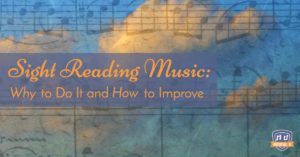Remember that magical jam session back in November, 20-blank-blank? When is it finally going to happen again? When will I sit down and experience the music flowing out of me with effortless, masterful expression?
The truth: while sometimes we get lucky, most of the time there’s a lot of time slogging around in the nitty-gritty before those magical moments become seconds, then minutes of pure musical bliss. That means practicing core musical skills, of course, but it also means growing your people and business skills to support your passion.
The trick is to make that eternal preparation period fun – or at least interesting!
This week, Musical U celebrates the nitty-gritty with posts on sight-reading, solfege, and online collaboration. But first, let’s look at what Musical U is doing to bring you cutting-edge music promo advice and to bridge the gap between the inner musical skills and our instruments.
What’s New in Musical U
Musical U focuses on the inner musical skills: the planning and practice, the many facets of ear training, playing by ear, solfa, singing in tune, and (more recently) improvisation. More and more, members have requested more help with transferring these skills onto their chosen instrument or voice.
To that end, this month we unveiled our new Instrument Packs for guitar, bass, piano and singing, and introduced our Resident Pro for each instrument – releasing our first resource pack for each one too, on the topic of beginning improvisation.
We also began our new program of master classes with a one-hour, roll-up-your-sleeves meeting with musicpreneur Tommy Darker on the subject of networking for musicians. Learn more about these new developments in What’s New in Musical U: June 2017:
Why Bother Learning to Sight-Reading Music?
Many musicians who don’t read music are concerned that it’s going to be difficult to learn. Others read a little, but either never fully embraced the skill, or had a bad experience with the way they were taught to sight-read. Still, others read ok but don’t know why they can’t seem to improve.
Wherever you are on the spectrum, take a moment to imagine being illiterate in today’s society – how much you would miss!
 Sight-reading music is a skill very much worth developing – and doesn’t have to be hard. Learn more about sight reading, and what you can do to do it better, in Sight Reading Music: Why to Do It and How to Improve.
Sight-reading music is a skill very much worth developing – and doesn’t have to be hard. Learn more about sight reading, and what you can do to do it better, in Sight Reading Music: Why to Do It and How to Improve.
Sight reading is not just a skill that a musician will need while learning music, but it is absolutely essential for the professional musician. This is especially true in the jazz music scene, where musicians can expect to sight-read music while on the actual gig… not just in the practice room. Check out this great podcast from Learn Jazz Standards on how to become an expert sight-reader.
That moment when the musician has to sight-read a piece of music can be scary and quite intimidating. So it is best to begin preparing early for becoming a master at this art! Music Notes has 10 Tips and Tricks that will help you to increase your sight reading abilities in your daily practice.
Improving your sight reading is not something that happens overnight, but is the result of a deliberate approach to your daily practice. Fortunately, many of the things that we should be doing to become better musicians are a part of this deliberate approach! It is worth noting that most of these fundamental skills are universal, and can be applied to nearly every instrument. Sarah Jeffery from Team Recorder knows how to improve your sight reading:
Improving your sight reading capabilities will not only help you in practical applications like auditions, but can make being a musician so much more pleasurable. Why?
Because being a great sight reader will result in you spending less time learning music, and more time playing music!
Polyphonic instruments like the piano present special reading issues. E-Music Maestro has 10 tips to improve your piano sight reading.
These Seven Little Syllables Will Change Your World
Do, re, mi, fa, sol, la, and ti – so much more than a drink with jam and bread! While many associate solfege (aka solfa) with children’s music education, these little syllables are jam-packed with important musical information for grown-ups, too. Learn more in this Introduction to Solfege:
How far can solfege musical training take you? For many musicians, it is only used in scale work or basic ear training, which fails to unlock the full potential of solfege to develop the relative pitch. This article from Harmony Road Music talks about solfege singing and the benefits that students gain from its application.
Fixed “do” or moveable “do” are the two main solfege systems. But what does this really mean and how can you determine which one works the best for you? My Music Expert talks about the background of these two systems:
Now that you have learned all about the solfege system, are you ready to begin using it? Becoming Singers will start you off with how to practice solfege scales in singing.
Solfege will not only help the musician with their ear training and overall musical abilities, but is a very effective tool to use while transcribing music. Sing Smarter has more information about how to transcribe music, and the great benefit that solfege has in this process.
Online Collaboration Tips
Making music with others can be the most exhilarating reward of playing music. But just because you rock the practice room doesn’t mean that other musicians are going to come knocking on your door.
 Online collaboration can make your musical dreams a reality, but holds its own special pitfalls. With a specially vetted bullpen of expert music pros, Tunedly is dedicated simplifying the process while opening up the most satisfying, high-performance collaboration experience ever. And they know from experience: no matter how digital we become, there’s no working around the people skills that make up the 5 Best Practices for Online Song Collaboration.
Online collaboration can make your musical dreams a reality, but holds its own special pitfalls. With a specially vetted bullpen of expert music pros, Tunedly is dedicated simplifying the process while opening up the most satisfying, high-performance collaboration experience ever. And they know from experience: no matter how digital we become, there’s no working around the people skills that make up the 5 Best Practices for Online Song Collaboration.
There are many tools that give musicians the ability to collaborate from afar, significantly more than were available only a couple of years ago. This has expanded the ease in which musicians can work and create music with other musicians all around the globe. But, what are the benefits of collaboration? Life and Death Productions explores five reasons why you should consider a musical collaboration.
On of the difficulties in online collaboration is managing who owns what part of the song(s) and making sure that proper credit is attributed. This will become especially important should royalties be realized from this project. Music Bed talks about the four types of music royalties.
The music industry has rapidly changed in the last 20 years, as consumers have moved from purchasing CDs to digital downloads and now primarily consuming music through streaming services. However, this transition hasn’t fully caught up with the artist, and many are still unaware of how they will make money from their music in these new online platforms. Spinditty may inspire you when you find out how musicians in South Korea have made money online.
We all have certain expectations for what music should sound like. These days, the amount of professional gear that is available to even the amateur musician has made understanding how to meet these expectations an even greater necessity. If you want to be taken seriously as a recording musician, you need to have a quality set up at home to record your music… but where to begin?
While there are thousands of options available, this helpful guide from Guitar Gear Finder will help you find a good starting point.
Our digital age provides fantastic opportunities – and a whole new level of skills to learn. And even with digital options like DAWs, the good old Western music notation system is unparalleled in its usefulness. And practicing solfege upgrades our inner musical software to fuel our outer musical expression. So click through this week’s Musical U posts for the nitty-gritty skills that will be the water, sun, and soil to your blossoming musical expression!







